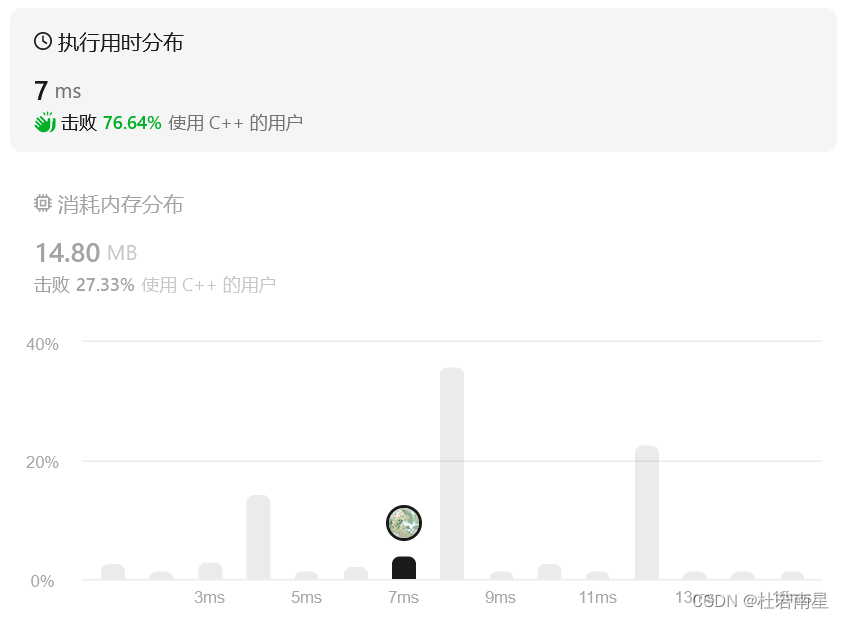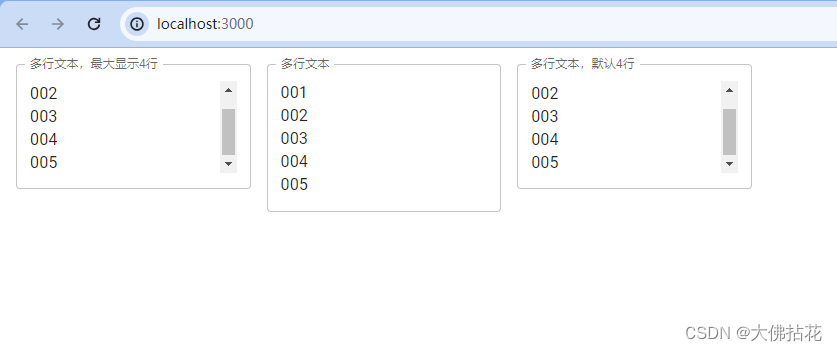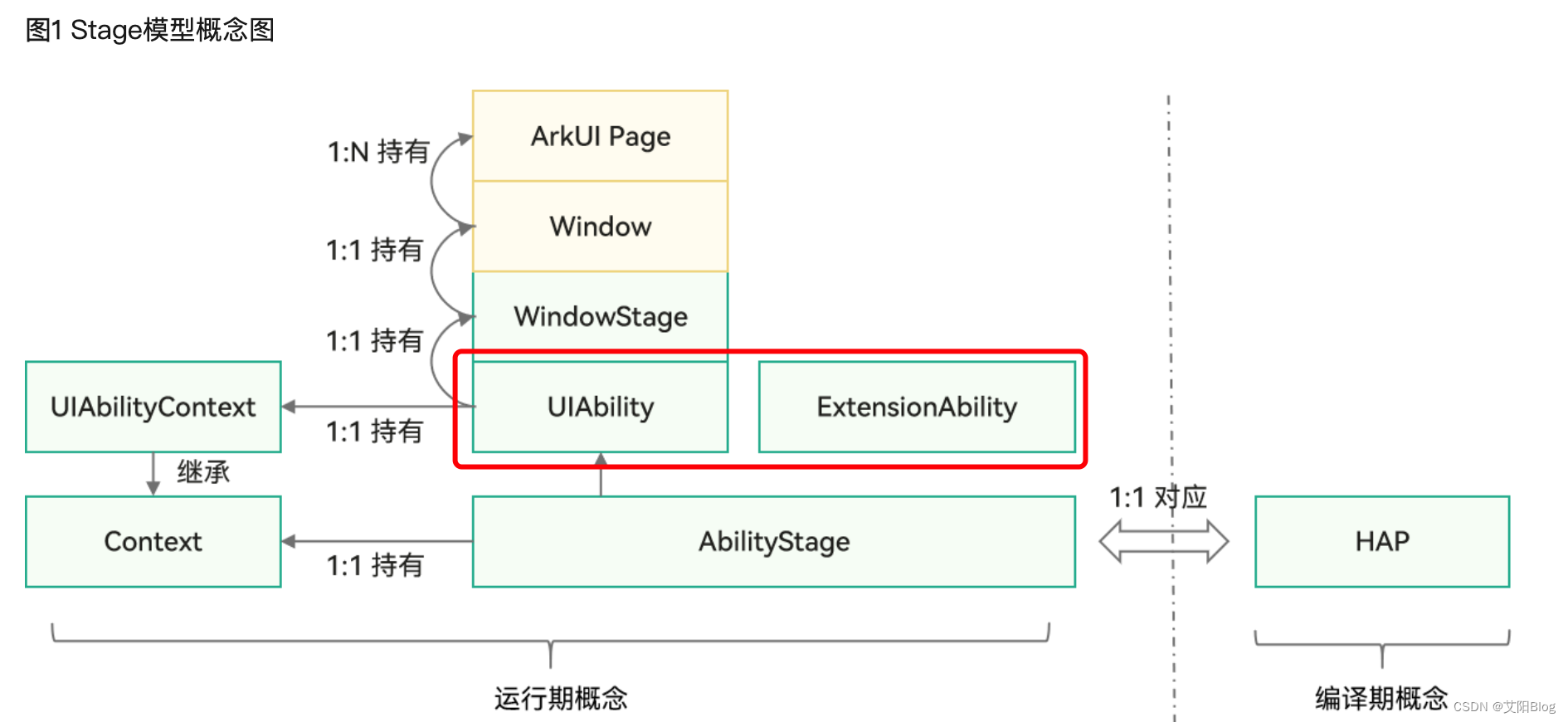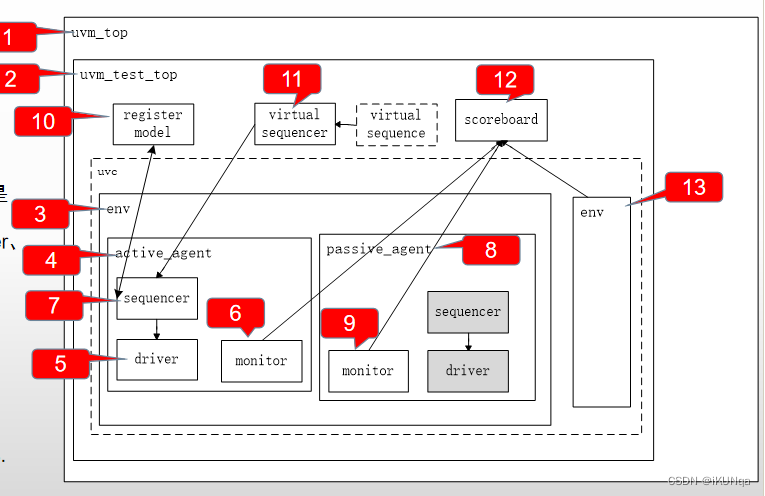前言
面试被问到好几次“channel是如何实现的”,我只会说“啊,就一块内存空间传递数据呗”…所以这篇文章来深入学习一下Channel相关。从源码开始学习其组成、工作流程及一些常见考点。
NO!共享内存
Golang的并发哲学是“要通过共享内存的方式进行通信,而是应该通过通信的方式共享内存。”
共享内存会需要使用锁、信号量等方式去控制访问,保障内存的一致性。所以会导致性能损耗+同步问题复杂。
“通过通信来共享内存”的理念强调在并发单元之间通过消息传递来交换数据,而不是直接共享内存。这样,每个并发单元都有自己的内存,不与其他并发单元共享。当它们需要共享数据时,它们会通过发送消息来完成。这种方法的优点是避免了使用锁和同步机制,从而降低了死锁和竞态条件的风险,简化了并发程序的设计和理解。
Channel整体结构
源码位置
位于src/runtime下的chan.go中。

Channel整体结构图
图源:https://i6448038.github.io/2019/04/11/go-channel/
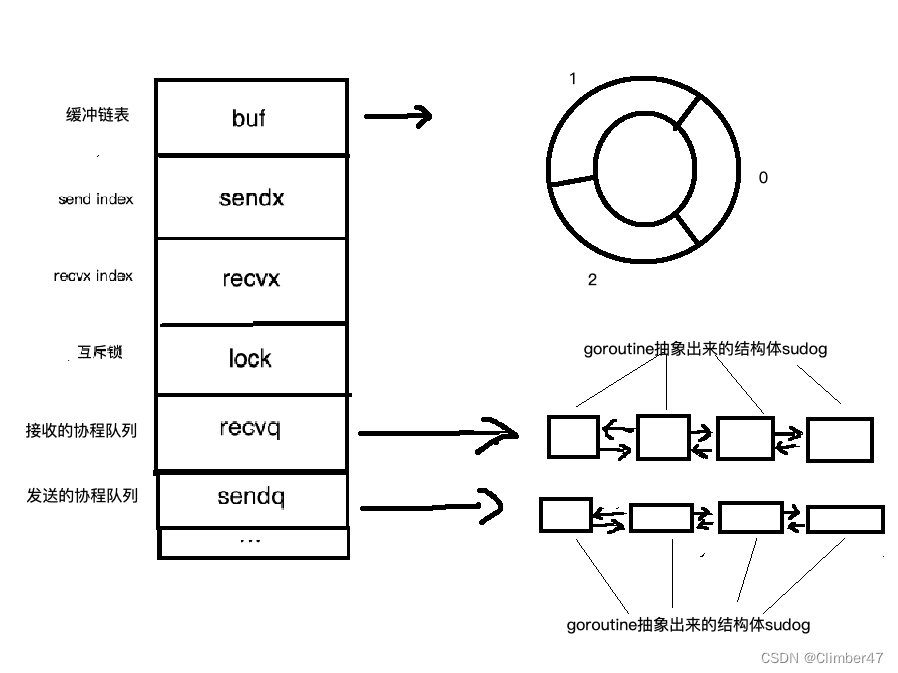
Channel结构体
type hchan struct {
qcount uint // total data in the queue
dataqsiz uint // size of the circular queue
buf unsafe.Pointer // points to an array of dataqsiz elements
elemsize uint16
closed uint32
elemtype *_type // element type
sendx uint // send index
recvx uint // receive index
recvq waitq // list of recv waiters
sendq waitq // list of send waiters
// lock protects all fields in hchan, as well as several
// fields in sudogs blocked on this channel.
//
// Do not change another G's status while holding this lock
// (in particular, do not ready a G), as this can deadlock
// with stack shrinking.
lock mutex
}
我们可以看到,其中有一个buf空间,这个对应的是我们生成的有缓冲通道、无缓冲通道。recvq和sendq对应的是waitq类型,其中主要存储的是发送、接受方的Goroutine。
waitq&&sudog
waitq:
type waitq struct {
first *sudog
last *sudog
}
sudog:
// sudogs are allocated from a special pool. Use acquireSudog and
// releaseSudog to allocate and free them.
type sudog struct {
// The following fields are protected by the hchan.lock of the
// channel this sudog is blocking on. shrinkstack depends on
// this for sudogs involved in channel ops.
g *g
next *sudog
prev *sudog
elem unsafe.Pointer // data element (may point to stack)
// The following fields are never accessed concurrently.
// For channels, waitlink is only accessed by g.
// For semaphores, all fields (including the ones above)
// are only accessed when holding a semaRoot lock.
acquiretime int64
releasetime int64
ticket uint32
// isSelect indicates g is participating in a select, so
// g.selectDone must be CAS'd to win the wake-up race.
isSelect bool
// success indicates whether communication over channel c
// succeeded. It is true if the goroutine was awoken because a
// value was delivered over channel c, and false if awoken
// because c was closed.
success bool
parent *sudog // semaRoot binary tree
waitlink *sudog // g.waiting list or semaRoot
waittail *sudog // semaRoot
c *hchan // channel
}
Channel工作流程
创建管道
先在创建阶段:会根据缓冲大小对buf进行初始化,无缓冲通道的buf为0。具体见
发送数据
发送数据前:
首先会进行加锁(因此-“一个通道同时只能进行一个收/发操作”)。如果Channel已关闭,则会报panic。
func chansend(c *hchan, ep unsafe.Pointer, block bool, callerpc uintptr) bool {
lock(&c.lock)
if c.closed != 0 {
unlock(&c.lock)
panic(plainError("send on closed channel"))
}
发送数据时,会分为多种情况:
1、有等待的接收者——直接发给阻塞的接收者。
2、无等待 但是缓冲区有空间——写入Channel的缓冲区。
3、无等待 无空间——等待其他Goroutine接受数据。
update:刚才脑子转不过来了一下。。疑惑:情况1的时候,那缓存内的东西先进去,不应该排队放后面吗?为什么直接丢给goroutine了。一下反应过来:如果缓存有内容,那接收者就直接拿了啊!!阻塞,就说明他已经缓存拿不到东西,才会去阻塞等待的。
工作流程:(由于GPT4.0解读源码总结完成)
1、检查通道是否为nil:如果尝试向一个nil的通道发送数据,如果是非阻塞的(block为false),则直接返回false;如果是阻塞的,则该goroutine会被挂起,直到被唤醒(实际上,向nil通道发送数据会导致永久阻塞,这里的唤醒仅是理论上的,因为后面紧接着会调用throw("unreachable")抛出异常,表示这个代码路径不应该被执行)。
2、快速路径检查:在尝试获取锁之前,先检查通道是否已关闭并且是否已满,以避免在这些明显无法发送成功的情况下还获取锁,提高效率。
3、获取锁:为了保证对通道状态的修改是安全的,需要先获取通道的锁。
4、检查通道是否已关闭:如果通道已经关闭,则抛出“send on closed channel”的异常。
5、尝试直接发送给等待接收的goroutine:如果有goroutine正在等待接收(即接收队列不为空),则直接将值传递给它,并唤醒该goroutine。
6、检查通道缓冲区是否有空间:如果通道的缓冲区还有空间,则将值放入缓冲区,并更新相关指标。
7、非阻塞发送失败:如果是非阻塞发送且到达这一步,说明无法立即发送,释放锁并返回false。
8、准备阻塞发送:如果是阻塞发送,则创建一个sudog对象表示当前goroutine,将其加入到发送队列中,并挂起当前goroutine等待被唤醒(通常是接收方接收到值或通道被关闭时唤醒)。
9、唤醒后的处理:被唤醒后,检查发送是否成功(通过检查sudog的success字段)。如果通道在等待期间被关闭,则抛出“send on closed channel”的异常。
10、资源清理和返回:最后,释放sudog资源,返回发送是否成功。
详细源码工作流程,见此
接收数据
当已被关闭&&缓冲区没有数据,会返回。
接收的三种情况:
1、存在发送者时,直接从发送者或缓冲区数据。
2、缓冲区存在数据,从缓冲区接收。
3、都不存在时,等待其他Goroutine发送。
源码阅读(chanrecv函数):
1、检查通道是否为空:如果尝试从一个nil的通道接收数据,根据block参数的不同,可能会导致goroutine挂起或者直接返回。
2、快速路径检查:在不阻塞的情况下,如果通道为空,则尝试检查通道是否关闭。如果通道已关闭且为空,则清空指针ep指向的内存(如果ep不为nil)并返回。
3、加锁:为了修改通道状态,需要先获取通道的锁。
4、通道已关闭且无数据:如果通道已关闭并且没有数据,清空ep指向的内存并返回。
5、从等待发送的goroutine接收数据:如果通道未关闭且有等待发送的goroutine,直接从发送方接收数据。
6、从通道缓冲区接收数据:如果通道有数据(qcount > 0),则从通道的缓冲区接收数据到ep指向的位置,并清空缓冲区中该数据的位置。
7、非阻塞情况下无数据可接:如果是非阻塞接收且到达这一步,说明无法立即接收数据,释放锁并返回。
8、准备阻塞接收:如果是阻塞接收,则挂起当前goroutine,直到有数据可接收或通道被关闭。
9、唤醒后的处理:被唤醒后,检查接收是否成功。如果接收成功,则ep指向的位置已被填充。
10、资源清理和返回:最后,释放相关资源,返回操作结果。
关闭管道
即closechan函数:
1、检查通道是否为nil:如果尝试关闭一个nil的通道,会引发panic。
2、加锁:为了保证对通道状态的修改是并发安全的,需要先获取通道的锁。
3、检查通道是否已经关闭:如果通道已经被关闭(c.closed != 0),则释放锁并panic。这防止了通道被多次关闭导致的未定义行为。
4、设置通道为关闭状态:将通道的closed标志设置为1,表示该通道已经关闭。
5、处理等待接收的goroutine:遍历接收队列recvq,对于队列中的每个等待接收的goroutine(通过sudog表示),清空它们等待接收的元素指针(如果有),并将它们标记为操作未成功(success = false)。这些goroutine将会被唤醒,但是接收操作会因为通道已关闭而失败。
6、处理等待发送的goroutine:遍历发送队列sendq,对于队列中的每个等待发送的goroutine,清空它们准备发送的元素指针(如果有),并将它们标记为操作未成功。这些goroutine在被唤醒后会感知到通道已经关闭,并可能引发panic。
7、释放锁:完成上述操作后,释放通道的锁。
8、唤醒所有goroutine:最后,对于通过上述步骤收集到的所有goroutine(存储在glist中),将它们标记为就绪状态(goready),这样它们就可以被调度执行了。这确保了所有因为该通道操作而阻塞的goroutine都能继续执行,无论是因为等待发送还是接收。
向已关闭的Channel收发,会如何?
结论
向已关闭的Channel发送,会报panic
向已关闭的Channel关闭,会报panic
从已关闭的Channel读数据,先读完缓冲区内容,之后会读出来0(各数据类型的默认值)
测试
省略测试代码,网上太多了。参考此文即可——https://segmentfault.com/a/1190000042297722
源码
关闭已关闭的/关闭nil的channel
if c == nil {
panic(plainError("close of nil channel"))
}
lock(&c.lock)
if c.closed != 0 {
unlock(&c.lock)
panic(plainError("close of closed channel"))
}
//chan.go---358行
向已关闭的channel发送
向nil的channel发送(nil通道和无缓冲通道还不是一回事,具体见我另一篇博文)
if c == nil {
if !block {
return false
}
gopark(nil, nil, waitReasonChanSendNilChan, traceBlockForever, 2)
throw("unreachable")
}
已关闭的发送
if c.closed != 0 {
unlock(&c.lock)
panic(plainError("send on closed channel"))
}
从已关闭的channel接收
依旧是先判断是否为无缓存、阻塞。
if c == nil {
if !block {
return
}
gopark(nil, nil, waitReasonChanReceiveNilChan, traceBlockForever, 2)
throw("unreachable")
}
if c.closed != 0 {
if c.qcount == 0 {
if raceenabled {
raceacquire(c.raceaddr())
}
unlock(&c.lock)
if ep != nil {
typedmemclr(c.elemtype, ep)
}
return true, false
}
// The channel has been closed, but the channel's buffer have data.
}
如何优雅的关闭Channel
这部分主要参考自:https://qcrao91.gitbook.io/go/channel/ru-he-you-ya-di-guan-bi-channel
直接关闭存在的问题
主要就是上述“向已关闭的Channel收发,会如何?”中所提到的情况:
1、向已关闭的channel中发送数据,会panic
2、重复关闭已经关闭的channel,会panic。
3、从已关闭的channel接收数据,收到的是0。
一个比较粗糙的实现
利用从读channel的,会返回bool的性质。
func IsClosed(ch <-chan T) bool {
select {
case <-ch:
return true
default:
}
return false
}
func main() {
c := make(chan T)
fmt.Println(IsClosed(c)) // false
close(c)
fmt.Println(IsClosed(c)) // true
}
但这样比较粗糙:
一来,对channel的状态进行了修改。
二来,检测的瞬间和关闭瞬间有间隔。
三来,多个同时调用的话,也可能重复关闭。
合理的方案
don't close a channel from the receiver side and don't close a channel if the channel has multiple concurrent senders.
即:不要从一个 receiver 侧关闭 channel,也不要在有多个 sender 时,关闭 channel。
因此考虑从发送端进行关闭。
单一sender的情况
即:
一个 sender,一个 receiver
一个 sender, M 个 receiver
对于这种情况,直接sender方,发完之后关了即可。
多个sender的情况
即:
N 个 sender,一个 reciver
N 个 sender, M 个 receiver
针对一个reciver的情况:
增加一个传递关闭信号的 channel,receiver 通过信号 channel 下达关闭数据 channel 指令。senders 监听到关闭信号后,停止接收数据。
func main() {
rand.Seed(time.Now().UnixNano())
const Max = 100000
const NumSenders = 1000
dataCh := make(chan int, 100)
stopCh := make(chan struct{})
// senders
for i := 0; i < NumSenders; i++ {
go func() {
for {
select {
case <- stopCh:
return
case dataCh <- rand.Intn(Max):
}
}
}()
}
// the receiver
go func() {
for value := range dataCh {
if value == Max-1 {
fmt.Println("send stop signal to senders.")
close(stopCh)
return
}
fmt.Println(value)
}
}()
select {
case <- time.After(time.Hour):
}
}
注意:这个代码中,其实并没有关闭channel。这个优雅的处理就是指的:不用他了,将他交给Golang的GC机制去处理。
针对多个reciver的情况:
如果依旧采取上述方案,则可能遇到的情况是:下达了多个关闭命令,依旧造成“向已关闭的channel进行关闭”。因此使用一个“中间人”channel,reciver都向他发送stop,收到第一个后 就向sender发stop。reciver默认长度设置为:Num(senders) + Num(receivers),可以避免阻塞问题。
此部分代码见参考链接的原文即可
其他注意事项
待补充
参考资料
小部分用到了GPT 4.0-0125进行辅助理解,已标注说明。
原理
https://draveness.me/golang/docs/part3-runtime/ch06-concurrency/golang-channel/#64-channel
https://i6448038.github.io/2019/04/11/go-channel/
https://zhuanlan.zhihu.com/p/496004953
关闭的收发
https://segmentfault.com/a/1190000042297722
优雅关闭
https://qcrao91.gitbook.io/go/channel/ru-he-you-ya-di-guan-bi-channel
